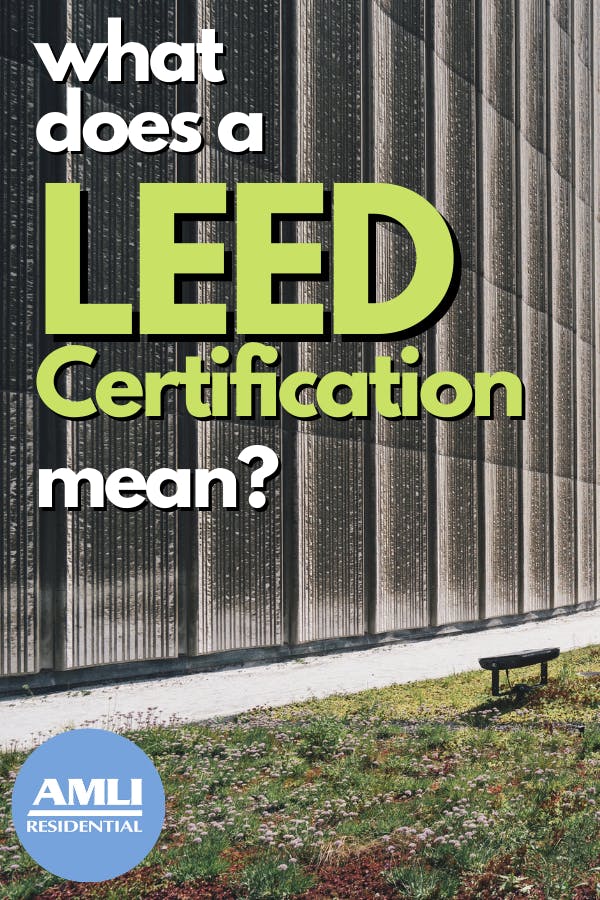If you are keeping up with sustainability in the news or are familiar with AMLI Residential’s sustainability practices, then you’ve probably heard the term LEED floated around before.
In the sustainability industry, LEED is the gold standard for creating a sustainable built environment that supports the planet and people’s health.
Although it’s impossible to completely delve into all the minor details of any sustainable practice in just one article, we can certainly help you understand the concept and overall idea of how LEED works.
What is LEED?
So what is LEED? In a nutshell, LEED is a certification system that’s used to rate buildings on a variety of eco-friendly factors. It stands for Leadership in Energy and Environmental Design and is used all over the world to develop greener communities and neighborhoods.
The United States Green Building Council (USGBC), a non-profit established in 1993, developed the LEED program in the organization’s early years. The process included collaborating with architects, engineers, developers, designers, government agencies, non-profits, manufacturers and many other industry leaders to identify and build upon green technology and strategies.
The first version of the LEED certification system came out in the late 1990s, and since then the certification system has evolved and upgraded as new technology, science and research also developed.
LEED today
LEED has certainly grown immensely since its start in the late ‘90s, and today there is a LEED rating system for practically every kind of building and phase of construction and operation. Within those systems are varying levels of achievement that the building can certify for, which we’ll explain in a second.
Here are the kinds of LEED rating systems that one could apply for today. Each category includes additional guidance for different types of buildings, such as schools, retail stores, old buildings, new buildings and so much more.
- Building Design and Construction
- Interior Design and Construction
- Building Operations and Maintenance
- Neighborhood Development
- Homes
- Cities and Communities
- LEED Recertification
- LEED Zero
If you’re looking for some context around these LEED rating systems, AMLI Residential has won awards in the LEED Homes category, which includes single family, multifamily low-rise and multifamily midrise.
How does LEED work?
As one can imagine, pursuing a LEED certification isn’t as easy as clicking a button and hoping for a “yes” or “no.”
Prerequisites
Like applying for any type of certification, there are certain qualifications that one must meet to even begin the application project.
All LEED certifications require points, which are gained through credits. Although project managers can choose what type of credits they want to apply for (and, therefore, the amount of points they will earn), they still need to make sure their buildings follow some basic standards for a LEED building. After all, the whole point of LEED is to create “healthier, more productive places for us to live, learn, work and play, as well as less stress on the environment, by encouraging energy- and resource-efficient buildings.”
The prerequisites differ for each kind of rating system, but some examples include improving indoor air quality through upgraded filters and increased ventilation, designing for energy efficiency, and creating a plan to recycle construction waste.
Credits
A project absolutely MUST meet the prerequisites in the chosen rating system, but the choice in credits is far more flexible.
The LEED credits are what make a building unique, as a project manager can choose what “achievements” the project can meet. Some credits are harder to achieve than others, but they also reward the building with more points (which is important for later!).
For example, a new construction project can gain a point for providing bicycle facilities, five points for having good rainwater management, and up to 34 points for optimizing the energy performance just during the design phase. Even though that’s just three credits, they all have different weights in points.
Points
We’ve already gone over how points are earned, but what exactly do the points do? This is where the certification levels come in.
- LEED Certified: 40-49 points
- LEED Silver: 50-59 points
- LEED Gold: 60-79 points
- LEED Platinum: 80+ points
As you can see, two buildings can have the same certification level but have reached that level through different combinations of credits. Whatever the combination of credits may be, LEED certification levels are a way to display that those in charge are committed to a greener, more eco-friendly world.
To sum it up
LEED certification, at its core, provides an achievable path to healthier, greener and more energy-efficient buildings. The prerequisites, credits and points are part of a framework that supports sustainable science and eco-friendly industries, and the certifications show what organizations are leaders in sustainable achievement.
If you live, work, play or learn in a LEED certified building, hopefully this will show you how much planning, work and leadership was involved in making that building more environmentally friendly. LEED certifications aren’t just gold star stickers handed out for planting trees or recycling boxes — they are complex systems that place great emphasis on not just the health of the people in the buildings, but also the environment affected by them.
Hope this helps!
Pin it!



 View All Posts by Colleen Ford
View All Posts by Colleen Ford